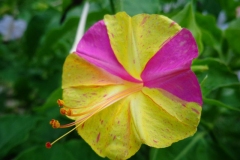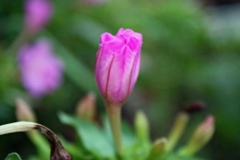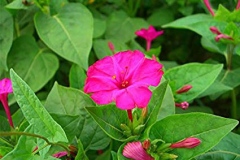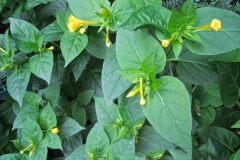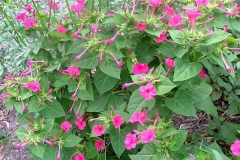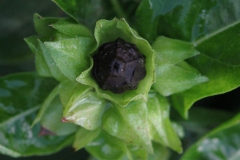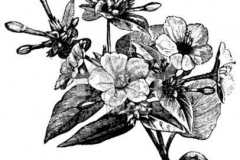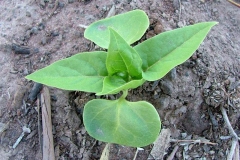Mirabilis Jalapa is the most commonly grown ornamental species available in a range of colors. The name of Mirabilis jalapa given by Carl Von Linne in 1753 is formed from the scientific Latin Mirabilis meaning “admirable” by reference to the remarkable colors of its flowers and the specific name jalapa that would refer to its origin in the Jalapa in Guatemala. But the epithet of Jalapa could also refer to the city of Xalapa (Jalapa) in Mexico from which came a former purgative drug, named jalap, taken from the tubers of the tuberous jalap.
Flowers usually open from late afternoon or at dusk (namely between 4 and 8 o’clock), giving rise to one of its common name 4 o’clock plant. Flowers then produce a strong, sweet-smelling fragrance throughout the night, and then close for good in the morning. New flowers open the following day. The flowers of the plant have no real petals. The calyx is in the place where the corolla should have been.
Plant Description
Marvel of Peru is an erect, bushy, branched, glabrous or slightly pubescent, perennial often grown as an annual plant that grows about 0.5–1 m tall and wide. The plant is found growing in cultivated fields, including cane fields, waste ground, disturbed sites, roadsides, abandoned fields, railways, margins of forests, shrub lands and pastures. Plant thrives in moderately fertile, moist but well-drained, sandy, loamy or chalky soil in full sun. The plant has blackish brown tuberous roots that can be a foot or more long. Stems are erect, square, thick, much branched, cylindrical, glabrous or slightly pubescent, thickened on nodes. All four o’clock plant die back to the roots each year.
Leaves
Leaves vary in shape, from narrowly linear to oval or heart shaped. Leaves occur opposite on the stems and have a short petiole about 1 to 4 cm long, without stipule. The lamina is fleshy, soft enough, oval, base truncate, rounded or slightly cordate and acute apex from 4 to 12 cm long and 3-8 cm wide. Leaf color ranges from grayish-green to dark green and the leaves have smooth edges. Some leaves are hairy, others are glabrous. The margin is entire, densely ciliated, hairs multicellular. The visible nerves are arched.
Flowers/Inflorescence
Flowers of the four o’clock family vary widely in color, from white to yellow, to pink, to magenta. All flowers are funnel-shaped, with 5 lobes and 3 long stamens which either extend out beyond the flower, or coil inside of the flower. Flowers occur in clusters of 1-5, most having 2-4. The corolla consists of five petals united into a long narrow tube flaring widely at the end. It measures 4-5 cm long and 3-4 cm wide. Each individual flower or cluster of flowers is surrounded by a whorl of bracts termed an involucre. These bracts, which resemble sepals, have apparently evolved from flowers originally found in clusters of three, where only one flower would develop to maturity. Several species in this genus (Mirabilis) have flowers which open during the late afternoon, which is why they have the common name, “Four O’ Clock”. The flowers are short-lived; they bloom at night, diminish the next morning and the corolla falls off very quickly. Flowering normally takes place from July to October.
Fruit
Fertile flowers are followed by leathery ribbed, plicate achene, sub globose to ellipsoidal from 6 to 8 mm long, with 5-10 longitudinal ribs, mute between the ribs. The fruits are initially green turning to black when mature.
Mirabilis Jalapa is grown in several parts of the world for the range of medicinal benefits it possesses. Some of the common medicinal uses of the herb include:
1. Curing Inflammation
One of the prominent medicinal uses of Mirabilis is in the treatment of inflammations. Leaves of the herb have got remarkable anti-inflammatory properties that make it very powerful against various kinds of skin inflammations. It is also due to this characteristic of the herb that it is used in the treatment of swellings.
2. Treatment of Wounds
Another medicinal use of Mirabilis Jalapa is in the treatment of wounds. Parts of the plant not only help in speeding up the healing process but also relieve pain.
3. Aphrodisiac
Libido enhancement is among the herb’s oldest and most popular uses. Given its aphrodisiac properties, Mirabilis Jalapa considerably raises the libido of a user. It is thus used as a treatment for people with low sex drive.
4. Diuretic and Purgative Uses
Studies indicate that Mirabilis possesses diuretic properties. This makes it an ideal substance for promoting diuresis which may be used in the treatment of several conditions that result from unhealthy production of urine. It also possesses laxative properties and has been used to boost healthy bowel movements in users. Among the conditions that the herb is used to treat due to its diuretic properties is dropsy.
Traditional uses and benefits of Marvel of Peru
- Root is aphrodisiac, diuretic and purgative and used in the treatment of dropsy.
- Tuberous root is a mild purgative and the fresh juice of the leaves is applied to the body to dispel heat and itching arising from dyspepsia.
- Paste of the root is applied as a poultice to treat scabies and muscular swellings in Nepal.
- Root juice is used in the treatment of diarrhea, indigestion and fevers.
- Powdered root, baked with corn flour, is used for the treatment of menstrual disorders.
- Leaves are considered diuretic; an infusion of the leaves is prescribed as a diuretic for dropsy and used to reduce inflammation.
- Leaf decoction is used to treat abscesses and leaf juice is used to treat wounds.
- Crushed leaves are used in India and Java for poulticing boils and abscesses and juice used for uterine discharges.
- Leaf juice is recommended internally in a mixture for gonorrhea in the Medical Book of Malayan Medicine.
- Tubers are used as a purgative in Europe, and in western India.
- Dried root is given with milk as a strengthening medicine.
- Pounded seeds are used in Peninsular Malaysia and elsewhere by Chinese and Japanese women for making cosmetic powder and are believed to remove acne.
- Powdered root is used with rice powder and sandalwood for the same purpose by Spanish women in Ternate and the juice of white flowers applied on the face when going out in the sun.
- The Malays use the plant to treat influenza, fever and inflammation, and the Chinese used it for Diabetes.
- Seed powder is used to treat infections in Thailand.
- Indigenous people of Mexico use Mirabilis Jalapa to cure many illnesses including dysentery, diarrhea, muscular pain and abdominal colic.
- Mirabilis Jalapa leaf infusions or decoction are used as traditional folk medicine in the south of Brazil to treat inflammatory and painful diseases.
- Mirabilis jalapa is extensively used for treatment of dysentery and vaginal discharge and as a laxative by Mexican people and for treatment of diarrhea, muscular pain and abdominal colic by people in the Easter Island, Guatemala and Brazil
- Kayapo Indians inhale the powdered dried flowers as a snuff for headaches in Brazil.
- The Assurani Indians grate the tuberous seeds and drink it for intestinal parasites.
- Indigenous Peruvian people use a root decoction as a diuretic.
- The Shipibo–Conibo Indians put the flowers in baths to treat colds and flu.
- Plant is used for mumps and bone fractures and as a uterine stimulant to hasten childbirth in United States.
- Roots of Mirabilis Jalapa are used traditionally in allergic skin disorders and asthma.
- Jalapa was one of many plants used for the treatment of gonorrhea in Guatemala.
- In Kivu, Democratic Republic of Congo, powder of the seeds is used for conjunctivitis.
- Juice of the flower and scrapings of banana stem is used for cataracts in animals.
- In Madagascar, washed root or root powder decoction is used with sugar in chicken soup as a purgative.
- Root pulp diluted in palm oil is used as local topical application for local application swellings in Popular Republic of Congo.
- Whole ripe fruit is dried, powdered and used locally for wounds in Burundi.
- Powdered dried roots are used to treat female sterility in Benin.
- Leaves are used as a magical charm in a sauce with belly of beef, fruits of Piper guineense and palm oil.
- Decoction of the five parts mixed with sugar and reduced to one-third the starting volume given for urinary infections and bladder stones.
- Leaves are also used to treat bumps and sores.
- Juice is applied to rashes to relieve itching.
- Leaves crushed with cold water are used as a poultice for broken and fractured bones, dislocations, and knotted muscles.
- Tuber is used in medicines for impotence.
- Powdered tuber, dried ginger, pepper, and peik-chin fruit are mixed with honey and licked for gonorrhea.
- In Brazilian herbal medicine, a paste is made of the leaf and flower and applied to affections of the skin such as itchiness, eczema, herpes, skin spots, and skin infections.
- Juice of the root is dropped into the ear for earaches.
- Brazilians also use the root to combat worms, intestinal parasites, leucorrhoea, edema, diarrhea, dysentery, abdominal colic, syphilis, and liver affections.
- Its consumption is an effective remedy for abnormal vaginal discharge and infections, as well as sexually transmitted diseases.
- Juice extracted from the flowers of the plant can be used as a topical treatment to clear herpes lesions.
- In some places, the plant has also been used to treat bone fractures.
Worldwide Ethno-medical Uses
| Marvel of Peru Quick Facts | |
|---|---|
| Name: | Marvel of Peru |
| Scientific Name: | Mirabilis jalapa |
| Origin | Tropical south America but has become naturalized throughout tropical and warm temperate regions |
| Colors | Green when young turning to black when mature |
| Shapes | Leathery ribbed, plicate, black, globose or ovoid achene, 5–9 mm across with white mealy endosperm |
| Health benefits | Cure Inflammation, Treats Wounds, gonorrhea, dysentery, diarrhea, muscular pain, abdominal colic, itching, skin infections,liver affections, Diabetes, colds and flu |
| Country | Uses |
| Brazil | For candida, chagas disease, colic, constipation, contusions, diarrhea, dysentery, earache, edema, eczema, freckles, herpes, hives, itch, intestinal parasites, liver problems, pain, skin problems, skin infections, syphilis, vaginal discharge, urinary insufficiency, wounds, worms |
| Cuba | For herpes, intestinal parasites |
| Guatemala | For abscesses, aches, boils, bruises, conjunctivitis, dermatitis, fungal infections, gonorrhea, inflammation, mucosal lesions, ringworm, scrofula, skin problems, sores, ulcers (skin), vaginal discharge, vaginitis, wounds |
| India | For conjunctivitis, edema, fungal infections, inflammation, pain, swellings |
| Mexico | For bee stings, dysentery, scorpion stings, vaginal discharge, wounds |
| Peru | For constipation, dermatitis, earaches, herpes, urinary insufficiency |
| USA | For abortions, bone fractures, childbirth, mumps |
| Elsewhere | For abscesses, arthritis, boils, bowel cleansing, burns, bruises, colic, constipation, diabetes, digestion stimulation, dropsy, dyspepsia, fungal infections, gonorrhea, hepatitis, herpes, hypochondria, intestinal gas, intestinal parasites, libido stimulation, liver problems, menstrual irregularities, muscle pains, piles, pimples, sores, splenitis, strains, syphilis, thrush, tonic, tumors, urinary insufficiency, urogenital inflammation, urticaria, wounds |
Culinary Uses
- Tender young leaves are cooked as a vegetable.
- An edible crimson dye is obtained from the flowers and is used for coloring cakes and jellies.
- Seed is crushed and used as a pepper substitute.
- It is an emergency food, only eaten when all else fails.
Other facts
- This species is used as a medicinal herb and as an ornamental in pots or in the ground.
- Mirabilis Jalapa flower extract was found to have use as a natural indicator in different types of acid–base titrations.
- This natural indicator was found to be very useful, economical, simple and accurate.
- Powdered seed is used as a cosmetic.
- It is also used for cosmetic powder, beads, for magical charms, and as a source of crimson dye.
- In India, the leaves are mixed with crushed garlic and given to hens, with the belief that they will yield more eggs.
- It is used widely as an ornamental plant due to the appearance of its flowers.
- The plant can also be used to remediate the condition of soils polluted with heavy metals like cadmium.
- In warm regions, the roots can weigh up to 18 kg or more.
Precautions
- Seeds and the roots are reported to cause digestive disturbances.
- Seeds have neuro-toxic chemicals. This has a poisoning effect on the body and should not be ingested at any cost.
- The plant has a uterine stimulant action and therefore it is better to avoid its consumption during pregnancy.
References:
https://www.itis.gov/servlet/SingleRpt/SingleRpt?search_topic=TSN&search_value=19648#null
https://davesgarden.com/guides/pf/go/92/
http://www.hear.org/pier/species/mirabilis_jalapa.htm
https://pfaf.org/user/Plant.aspx?LatinName=Mirabilis+jalapa
https://www.cabi.org/isc/datasheet/34254
http://www.missouribotanicalgarden.org/PlantFinder/PlantFinderDetails.aspx?kempercode=a595
http://www.floracatalana.net/mirabilis-jalapa-l-
https://plants.usda.gov/core/profile?symbol=MIJA
https://en.wikipedia.org/wiki/Mirabilis_jalapa
https://npgsweb.ars-grin.gov/gringlobal/taxonomydetail.aspx?24469
http://www.theplantlist.org/tpl1.1/record/kew-2502156
https://gd.eppo.int/taxon/MIBJA
https://extension.usu.edu/rangeplants/forbsherbaceous/four-oclock
https://indiabiodiversity.org/species/show/266323



